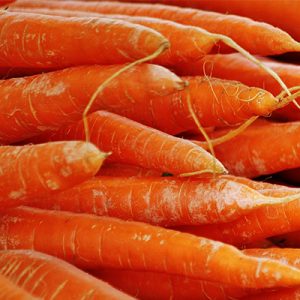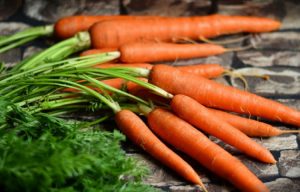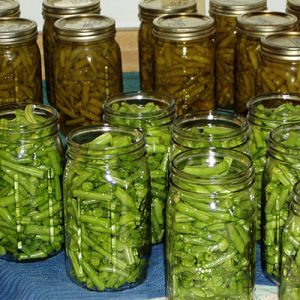Bulletin #4382, Canning Vegetables In a Pressure Canner
Canning & Freezing Quick-Guides
Bulletin #4382, Canning Vegetables In a Pressure Canner (PDF)

Prepared by Ann Hamilton, Food Safety Field Specialist, University of New Hampshire; reproduced with permission.
For information about UMaine Extension programs and resources, visit extension.umaine.edu.
Find more of our publications and books at extension.umaine.edu/publications/.
Pressure canning is the only recommended method for canning meat, poultry, seafood, and vegetables. The bacterium Clostridium bolulinum is destroyed in low-acid foods when they are processed at the correct time and temperature in pressure canners. Using boiling water canners for these foods poses a real risk of botulism poisoning.
Steam pressure processing works when the heat is applied to a sealed pressure canner allowing the pressure to build up in the canner. The water inside the canner forms steam, which replaces the air in the canner. When the vents are closed, only pressurized steam hotter than boiling water remains in the canner and heat penetrates the food. Pressure canners reach an internal temperature of 240 – 250 degrees Fahrenheit.
For more information on pressure canning and charts on processing times, download the fact sheet Bulletin #4382, Canning Vegetables In a Pressure Canner (PDF).
Visit the Elevation Map for Localities website for information on determining your altitude. Input your physical address and location to get your exact altitude.
Steam Pressure Processing
When heat is applied to a sealed pressure canner, pressure builds up inside the canner. The water inside the canner forms steam, which replaces the air in the canner. When the vents are closed, only pressurized steam hotter than boiling water remains in the canner and heat penetrates the food. Pressure canners reach an internal temperature of 240° – 250° F. Know your altitude and adjust the amount of pressure accordingly.*
General Directions
Work quickly and complete the entire process in one session. Raw pack or hot pack foods following the directions below. If desired, add ½ teaspoon salt to pints and 1 teaspoon of salt to quart jars. Vegetables may be canned without salt as salt isn’t needed as a preservative.
Hot Pack
Fill hot jars with hot vegetables; add boiling-hot cooking liquid or boiling water leaving 1-inch headspace at top of the jar. Remove air bubbles. Wipe jar rims. Adjust lids and process.
Raw Pack
Cover raw vegetables in hot jars with boiling water leaving 1-inch headspace. Remove air bubbles. Wipe jar rims. Adjust lids and process.
Pressure Canning Procedures
- Put 2 to 3 inches of water in the bottom of the pressure canner.
- While keeping pre-filled jars upright, place them on a rack at the bottom of the canner.
- Heat the canner to boiling and exhaust steam from the canner for 10 minutes before adding the weight or closing the petcock.
- Add weight or pressure regulator. *Adjust the pressure based on your altitude.
- Allow pressure to rise and maintain at the level called for in the tested recipe below by adjusting the heat. If the pressure goes below the recommended pressure at any time during processing, reset your timer to zero and restart the entire processing time.
- After processing time is complete, remove the canner from heat and allow the canner to cool naturally to 0 pounds pressure. Wait 2 minutes and remove the weighted gauge or pressure regulator. Wait 10 more minutes before removing the lid.
WARNING: Low-acid vegetables MUST be processed in a pressure canner to minimize the risk of food spoilage.
Notes:
- *Canning at Higher Altitudes: As altitude increases, water boils at lower temperatures. Therefore, canning pressure must be increased to ensure a safe product.
- Dial Gauge Canner: For altitudes of 2,001 to 4,000 ft. process at 12 lbs. of pressure for the recommended time.
- Weighted Gauge Canner: For altitudes above 1,000 ft. process at 15 lbs. of pressure for the recommended time.
Preparing Low-Acid Vegetables for Canning
Asparagus
- Preparation: Cut into 1” pieces or can whole.
- Hot pack: Cover with boiling water. Boil 2-3 minutes. Loosely fill hot jars with hot asparagus. Fill jars with boiling water or cooking liquid.
- Raw pack: Pack hot jars tightly with raw asparagus. Fill jars with boiling water.
- Jar Size and Processing Time: Pints 30 Minutes; Quarts 40 Minutes
- Dial Gauge Canner* Pressure at Altitudes of 0-2,000 ft.: 11 Lb.
- Weighted Gauge Canner* Pressure at Altitudes of 0-1,000 ft.: 10 Lb.
Beans (snap, wax, or Italian)
- Preparation: Wash, trim ends. Leave whole or cut or snap into 1” pieces.
- Hot pack: Cover with boiling water, boil 5 minutes. Loosely fill hot jars with hot beans. Fill jars with boiling hot cooking liquid.
- Raw pack: Pack hot jars tightly with raw beans. Fill jars with boiling water.
- Jar Size and Processing Time: Pints 20 Minutes; Quarts 25 Minutes
- Dial Gauge Canner* Pressure at Altitudes of 0-2,000 ft.: 11 Lb.
- Weighted Gauge Canner* Pressure at Altitudes of 0-1,000 ft.: 10 Lb.
Beets (whole, cubed, or sliced)
- Preparation: Sort for size. Cut off tops, leaving 1” stem and root. Wash. Cover with boiling water, boil until skins slip off easily. Skin, trim off stem and root. Leave baby beets whole. Cut medium and large beets into ½” cubes or slices. Halve or quarter large slices.
- Hot pack: Fill hot jars with hot beets and fresh boiling water.
- Jar Size and Processing Time: Pints 30 Minutes; Quarts 35 Minutes
- Dial Gauge Canner* Pressure at Altitudes of 0-2,000 ft.: 11 Lb.
- Weighted Gauge Canner* Pressure at Altitudes of 0-1,000 ft.: 10 Lb.
Carrots
 Preparation: Wash, peel, & rewash. Slice or dice.
Preparation: Wash, peel, & rewash. Slice or dice.- Hot pack: Cover with boiling water, bring to a boil, simmer 5 minutes. Fill hot jars with hot carrots. Fill jars with boiling water or cooking liquid.
- Raw pack: Pack hot jars tightly with raw carrots. Fill jars with boiling water.
- Jar Size and Processing Time: Pints 25 Minutes: Quarts 30 Minutes
Corn, Cream Style
- Preparation: Husk corn, remove silk, wash. Blanch ears 4 minutes in boiling water. Cut corn from cob at the center of the kernel then scrape remaining corn from cob with a knife.
- Hot pack: Add 1 cup of boiling water to every 2 cups of corn. Heat to boiling. Fill hot pint jars with hot corn mixture.
- Jar Size and Processing Time: Pints 85 Minutes only
- Dial Gauge Canner* Pressure at Altitudes of 0-2,000 ft.: 11 Lb.
- Weighted Gauge Canner* Pressure at Altitudes of 0-1,000 ft.: 10 Lb.
Corn, Whole
- Preparation: Husk corn, remove silk, wash. Blanch 3 minutes in boiling water. Cut corn from cob about ¾ depth of kernel. (Do not scrape cob.)
- Hot pack: Add 1 cup of boiling water to each 4 cups corn and heat to boiling. Simmer 5 minutes. Fill hot jars with hot corn. Fill the jar with boiling hot cooking liquid.
- Raw pack: Pack hot jars with raw kernels. (Don’t shake or press down.) Fill jars with boiling water
- Jar Size and Processing Time: Pints 55 Minutes; Quarts 85 Minutes
- Dial Gauge Canner* Pressure at Altitudes of 0-2,000 ft.: 11 Lb.
- Weighted Gauge Canner* Pressure at Altitudes of 0-1,000 ft.: 10 Lb.
Peas, Green
- Preparation: Shell and wash peas.
- Hot pack: Cover peas with water in a pan. Bring to a rolling boil and boil 2 minutes. Loosely fill hot jars with hot peas. Fill the jar with boiling cooking liquid.
- Raw pack: Pack hot jars with raw peas. (Don’t shake or press down.) Fill the jar with boiling cooking liquid.
- Jar Size and Processing Time: Pint 40 Minutes; Quarts 40 Minutes
- Dial Gauge Canner* Pressure at Altitudes of 0-2,000 ft.: 11 Lb.
- Weighted Gauge Canner* Pressure at Altitudes of 0-1,000 ft.: 10 Lb.
Potatoes, white-cubed or whole
- Preparation: Wash and peel. Choose potatoes 1-2 inches in diameter for canning whole. Or, if desired, cut into ½” cubes. Place in ascorbic acid solution to prevent darkening (see below). Drain.
- Hot pack: Cook whole potatoes 10 minutes or cubed potatoes 2 minutes in boiling water. Drain. Fill hot jars with hot potatoes. Fill jars with fresh boiling water.
- Jar Size and Processing Time: Pints 35 Minutes; Quarts 40 Minutes
- Dial Gauge Canner* Pressure at Altitudes of 0-2,000 ft.: 11 Lb.
- Weighted Gauge Canner* Pressure at Altitudes of 0-1,000 ft.: 10 Lb.
Pumpkin and Winter Squash, Cubed
- Preparation: Small, stringless pumpkin such as sugar or pie pumpkins work best. Wash, remove seeds, cut into 1” wide slices, peel. Cut the flesh into 1” cubes.
- Hot pack: Boil 2 minutes in water. Do not mash or puree. Fill hot jars with hot cubes. Fill jars with boiling cooking liquid.
- Jar Size and Processing Time: Pints 55 Minutes; Quarts 90 Minutes
- Dial Gauge Canner* Pressure at Altitudes of 0-2,000 ft.: 11 Lb.
- Weighted Gauge Canner* Pressure at Altitudes of 0-1,000 ft.: 10 Lb.
Spinach and Other Greens
- Preparation: Wash freshly harvested leaves until free of grit. Cut out tough stems and midribs. Hot pack: Steam blanch 1 lb. greens 3-5 minutes. Loosely fill hot jars with hot greens. Fill jars with fresh boiling water.
- Jar Size and Processing time: Pints 70 Minutes; Quarts 90 Minutes
- Dial Gauge Canner* Pressure at Altitudes of 0-2,000 ft.: 11 Lb.
- Weighted Gauge Canner* Pressure at Altitudes of 0-1,000 ft.: 10 Lb.
Mixed Vegetables, except greens, dried beans, cream-style corn, summer or winter squash, or sweet potatoes
- Preparation: Equal portions of carrots, whole kernel sweet corn, cut green beans, lima beans, crushed tomatoes, and cubed zucchini make a good mix. Prepare all vegetables for canning except zucchini. Wash, trim and dice zucchini.
- Hot Pack: Mix all vegetables together, add boiling water to cover, and bring to a boil. Boil 5 minutes. Fill hot vegetables into hot jars. Fill jars with boiling water.
- Jar Size and Processing Time: Pints 75 Minutes; Quarts 90 Minutes
- Dial Gauge Canner* Pressure at Altitudes of 0-2,000 ft.: 11 Lb.
- Weighted Gauge Canner* Pressure at Altitudes of 0-1,000 ft.: 10 Lb.
Did You Know?
It is important to allow steam to escape the pressure canner for 10 minutes before adding the weight or petcock, even if the canner is labeled as “self-exhausting”. This allows the air to be removed from the canner. Air that is trapped in the canner will prevent adequate heating of the jars and may cause the pressure gauge to give a false reading.
For More Information
For more information on food preservation, go to the National Center for Home Food Preservation Website.
New Hampshire Extension
State Office
Taylor Hall
59 College Rd.
Durham, NH 03824
Education Center and Information Line
answers@unh.edu
1.877.EXT.GROW (1.877.398.4769)
9:00 a.m.–2:00 p.m., Monday-Friday
Search keywords: “UNH Education Center”
Information in this publication is provided purely for educational purposes. No responsibility is assumed for any problems associated with the use of products or services mentioned. No endorsement of products or companies is intended, nor is criticism of unnamed products or companies implied.
© 2007, 2009, 2019
Call 800.287.0274 (in Maine), or 207.581.3188, for information on publications and program offerings from University of Maine Cooperative Extension, or visit extension.umaine.edu.
In complying with the letter and spirit of applicable laws and pursuing its own goals of diversity, the University of Maine System does not discriminate on the grounds of race, color, religion, sex, sexual orientation, transgender status, gender, gender identity or expression, ethnicity, national origin, citizenship status, familial status, ancestry, age, disability physical or mental, genetic information, or veterans or military status in employment, education, and all other programs and activities. The University provides reasonable accommodations to qualified individuals with disabilities upon request. The following person has been designated to handle inquiries regarding non-discrimination policies: Director of Institutional Equity and Title IX Services, 5713 Chadbourne Hall, Room 412, University of Maine, Orono, ME 04469-5713, 207.581.1226, TTY 711 (Maine Relay System).



